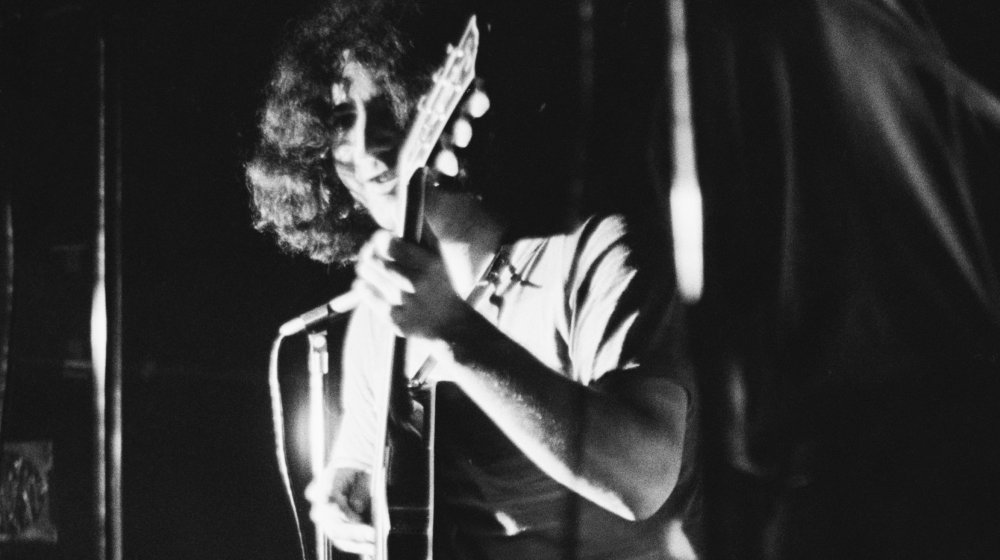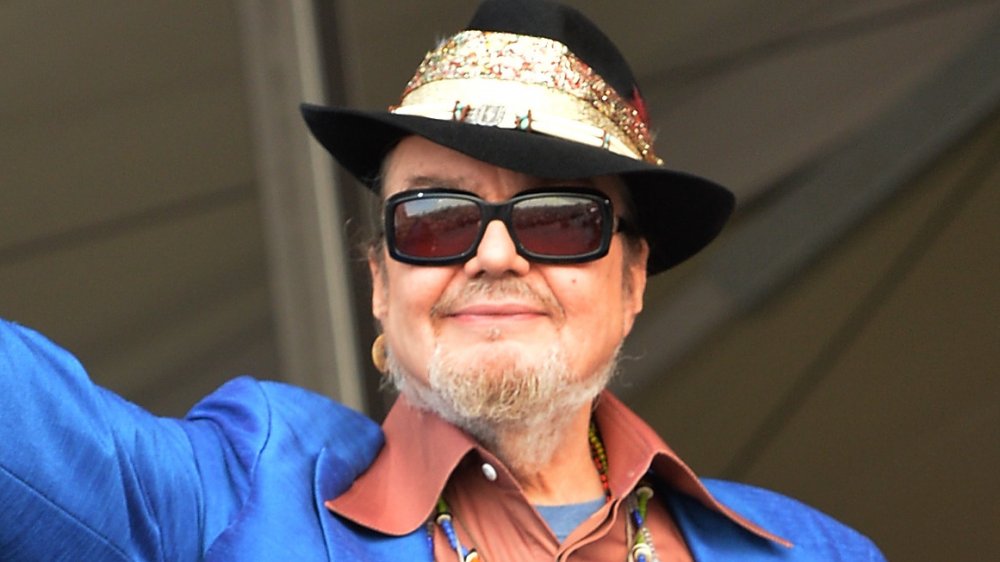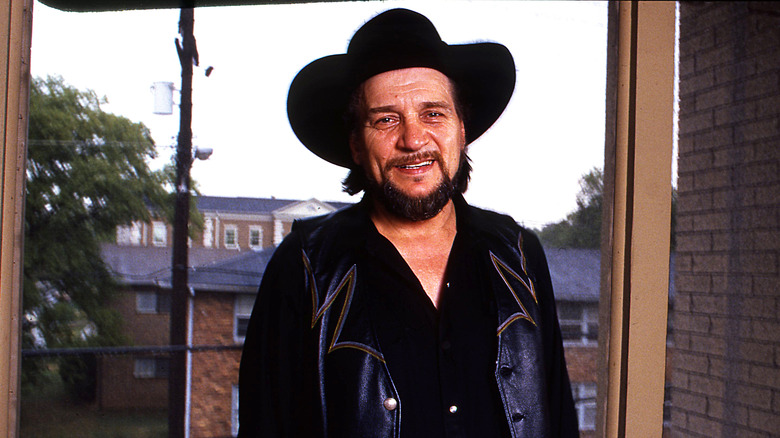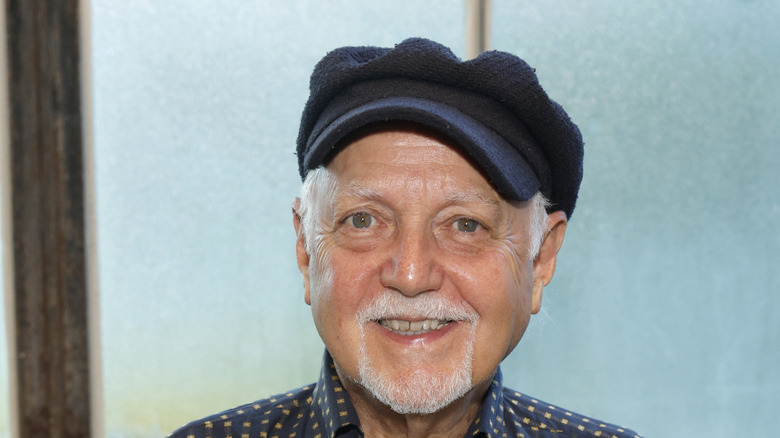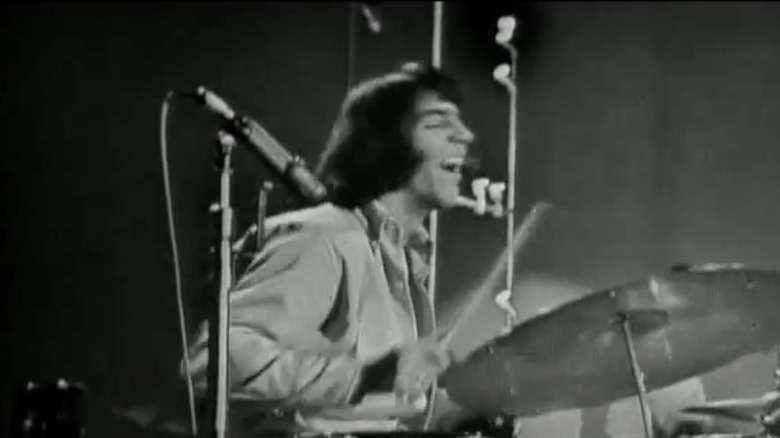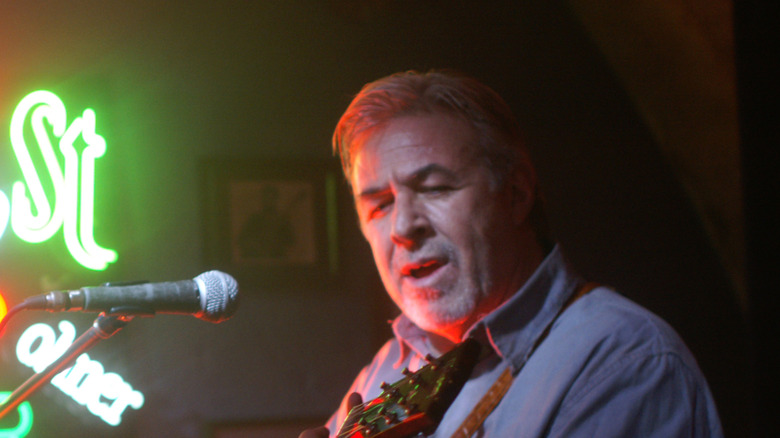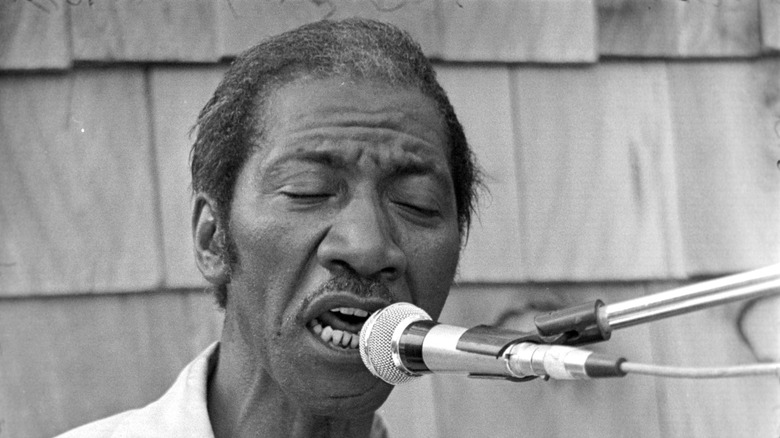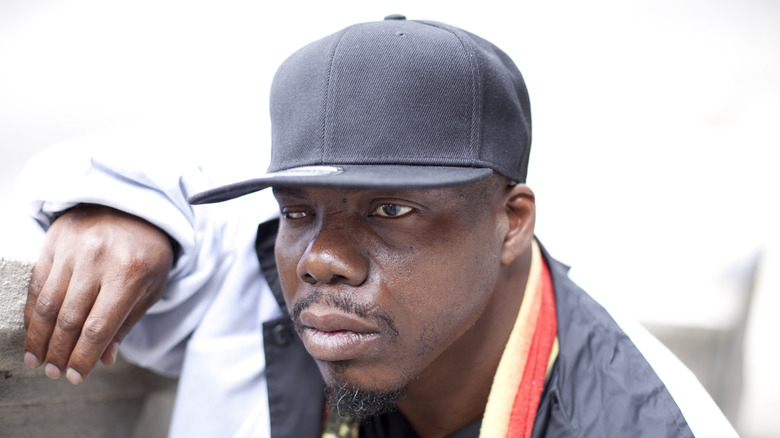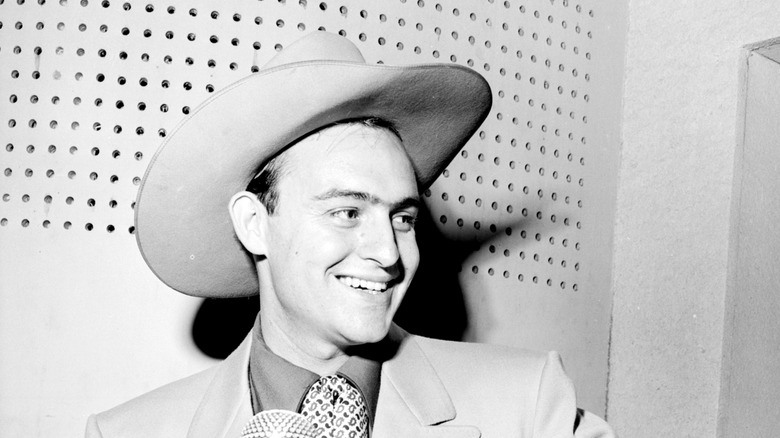Rock Stars You May Not Know Are Missing Body Parts
Being a rock star has to be one of the greatest jobs — and feelings — in all of existence. Not only do these lucky individuals get to spend their lives following their creative muse, but they also get well-compensated for their troubles in the form of financial riches and the unending adulation of appreciative fans. Ranking much farther down that hypothetical list of "things that would be nice for a human being to experience" is losing a portion of one's body to injury, illness, accident, or congenital anomaly.
Fingers, legs, arms, bones — these limbs and appendages really become a part of a person. Lacking a vital element of the body, one that most everyone else on the planet takes for granted, can understandably cause major obstacles. And that's especially true if your whole job is being a rock star and making music with, you know, your body. However, the musicians on this list overcame those challenges and went on to live grand lives. From old-timey performers to heavy metal stars, these famous rock stars had incredible careers even though they were missing various body parts.
Jerry Garcia's missing finger
Almost anybody can pick up a guitar and learn to play it. However, a handful of guitarists go on to form bands and make enduring art that brings them fame and fortune. But only a precious few of those musicians go on to inspire a thriving subculture, a la Jerry Garcia, the merry leader of the Grateful Dead, the original jam band and source of near-worship by its army of Deadheads. Garcia and company trucked along on a seemingly endless tour for 30 years (from 1965 until Garcia's death from a host of medical problems, including a heart attack). And to think he became one of the world's most acclaimed and well-known guitarists with only nine fingers (especially impressive considering how important fingers are for a musician).
When they were both kids, Garcia's older brother, Tiff, cut off Jerry's finger with an ax. Of course, it was (kinda) accidental. "He was putting little pieces of twigs on the sawhorse, or whatever, and I was chopping them in half, making kindling," Tiff related on the Garcia tribute DVD "Move Me Brightly," before adding, "He'd put his finger there and take it away. That happened a dozen times. Finally, I just nailed him. So they had to remove it."
Tony Iommi lost the tips of his fingers
In the early 1970s, singer Ozzy Osbourne and Black Sabbath pioneered heavy metal, combining a loud, dark, and grungy sound with wailing lyrics about war, death, mental illness, and other things contemporaries like Three Dog Night didn't dare to cover. It's fitting, then, that one of the chief architects of metal, Black Sabbath guitarist Tony Iommi, paid the bills before his music career took off by working in a sheet metal factory in the English industrial city of Birmingham.
Iommi worked as a welder, but one day, he was moved to a different part of the factory and put to work on a "giant, huge press — a guillotine-type press." As Iommi explained to Loudwire, "I don't know what happened, I must have pushed my hand in. Bang! It came down. It just took the ends off." The ends off what? Well ... his fingers. His right-hand ring and middle fingers, to be precise. "It was left with two stalks, the bone was sticking out the top of the finger," he explained. Doctors cut off the bones and told Iommi that without a full hand of fingers, his guitar-playing days were over, a fate he couldn't accept. So instead, he created prosthetic tips out of everything from melted plastic to cloth, finally deciding that cut-up bits of a leather jacket gave him the leverage to grip down on guitar strings.
Rick Allen lost his arm
In 1996, the humorous rap-rock group the Bloodhound Gang released the single "Why's Everybody Always Pickin' on Me?" It included a shouted refrain that went, "The drummer from Def Leppard's only got one arm!" So what's that about? Well, they're pickin' on Rick Allen, who really was left with one upper appendage after a New Year's Eve 1984 car accident.
While driving on the A57 motorway outside Def Leppard's hometown of Sheffield, England, Allen's Corvette Stingray slipped out of his control. It struck a brick wall at a high speed, and the impact came at such tremendous force that it unbuckled Allen's seatbelt. As the car expelled him via the sunroof, his arm got caught on the seatbelt ... and detached from the rest of his body. Amazingly, Allen spent only a month in the hospital and resumed his duties behind the kit for Def Leppard in August 1986. He obviously couldn't play the drums the way he used to, so ever since, he's been assisted by a pedal-powered, electronic drumming system.
Paul Stanley was missing an ear for a long time
Buried under black-and-white face makeup that presented him to the world as "the Starchild," KISS singer and guitarist Paul Stanley played some of the loudest music in the world to arenas packed full of adoring fans in the '70s and beyond. KISS concerts probably shattered more than a few eardrums, but long before he rocked and rolled all night and partied every day, Stanley began life with major hearing problems. "I was born with a Level 3 Microtia, which is a congenital deformity of the cartilage of the outer ear," he told CNN. He went on to explain that "there is no ear canal and no direct path to the inner workings of the ear."
The condition left the young Stanley "virtually deaf" on his right side, and it also gave him an underdeveloped mound of flesh where his outer ear would've been. As an adult, the singer corrected both issues. Along with receiving implanted hearing aids, a surgeon removed cartilage from Stanley's rib cage and made an artificial ear out of it, which was then grafted to his head.
James 'Munky' Shaffer is missing part of his finger
Of all the nu-metal bands that stormed the album charts and the "TRL" studios in the late '90s and early 2000s, Korn sat at the top of the tattooed heap. Hardcore Korn-heads couldn't get enough of the gravelly vocals of Jonathan Davis, the low-end grooves of bassist Reginald "Fieldy" Arvizu, and the intricate guitar work of Brian "Head" Welch and James "Munky" Shaffer. According to Leah Furman's "Korn: Life in the Pit," a teenage Shaffer actually started playing the guitar in the first place as a form of physical therapy. But why did he need therapy, you ask?
Well, one night, 14-year-old Munky tried to sneak out of his house to attend a keg party. As he attempted to ride away, the bike chain came loose and started making a loud, repetitive noise. Seeking to silence the bike so as to not get caught by his parents, he grabbed hard at the chain. And that's when the chain and teeth of the sprocket on the moving bicycle trapped young Munky's left index finger, mangling it horribly. While he initially had no feeling in the partially severed finger, doctors recommended the teen play an instrument as therapy to help the sensation return, and the rest is history.
Leslie West lost part of his leg
In the summer of 1969, the hard rock band Mountain secured both its legacy and its Baby Boomer generational cred forever when it played a set at the Woodstock Festival. The group's biggest hit, the riff-and-cowbell-heavy "Mississippi Queen," reached No. 21 on the Billboard Hot 100 and endured as a classic rock radio staple and beer commercial background music. Co-founder, guitarist, and singer Leslie West kept playing music in various bands and as a solo act, even after a personally devastating partial leg amputation in 2011.
"I cried a couple f****n' times. I look down — 'Where is it?!'" West told Billboard of the aftermath of the surgery, in which doctors removed the lower half of his right leg due to the ravages of diabetes. West now gets around with the aid of wheelchairs, which he considers good luck. "But I'll tell you. It's a good thing it wasn't one of my arms. Then I'd really be f****d," he said, because he doesn't need a leg to play the guitar and make music.
Dr. John could've lost his life but lost a finger instead
The late Dr. John (real name Malcolm John Rebennack) took the unique sound of New Orleans, put a pop-rock spin on it, and brought it to the mainstream in the '60s and '70s. With a little bit of blues, a little bit of jazz, and a little bit of funk, the raspy-voiced Big Easy icon is most remembered for his 1973 Top 10 hit "Right Place Wrong Time," notable for Dr. John's blazing keyboard work.
He came relatively late to key-based instruments, after he'd established a career as a live and session musician, but he kind of had no choice. In a 1960 show in Jackson, Mississippi, Dr. John was playing his first main instrument, the guitar, with a band. A fight broke out, somebody pulled out a gun, the gun went off, and the bullet struck Dr. John in the ring finger of his left hand. It's amazing the force didn't blow the thing clean off, but Dr. John couldn't move it for so long that his guitar work suffered. And so, he switched to piano and keyboards, and he did pretty well for himself in the long run.
Fredrik Thordendal lost part of his finger
Meshuggah is among the loudest, heaviest, and most metal bands that ever metaled. The Swedish outfit has been a going concern for more than 30 years now, combining unique rhythms and jazz elements with some good, old-fashioned thrash to create a distinctive, rumbling sound all its own. A lot of that auditory assault comes courtesy of founding member Fredrik Thordendal, named by Guitar World as one of the best heavy metal guitarists of all time.
But in the mid-'90s, well after the band had released several collections and established an international following, Thordendal suffered a setback. While working on a carpentry project, he sliced off the tip of the middle finger on his left hand, or his fretting hand. Doctors sewed it back on, leaving the damaged finger and index finger the same length. More importantly, he was able to play again, and this story is arguably as metal as anything Meshuggah has ever recorded.
Andrew Tkaczyk has a missing leg
In November 2015, a bus carrying the popular metalcore band the Ghost Inside, along with its crew, collided with an 18-wheeler truck. The drivers of both vehicles died in the accident, while the whole of the band's operations survived, although some just barely. Early reports listed vocalist Jonathan Vigil and guitarist Zach Johnson in critical condition. Drummer Andrew Tkaczyk was airlifted out of the scene of the crash for treatment of head trauma and multiple bone breaks.
From the hospital, where he would spend two months after the crash, Tkaczyk posted to Instagram an update on his recovery in January 2016. He revealed that after the accident left him in a coma for 10 days, he awoke "to the sight of my missing leg." Surgeons had to amputate the severely damaged appendage, which Tkaczyk notes was "one injury among many others such as fractures in my ribs, spine, and hip along with some ligament tears in my rotator cuff and labrum." He promised to "play drums again," and he did. The Ghost Inside returned to the stage in 2019 for its first show since the bus accident and has released two more studio albums to date.
How Fetty Wap lost his eye
If rock stars put forth a unique, imitable style and create music that speaks to the issues of a youthful generation while simultaneously upsetting and offending that audience's parents, then rappers are definitely the new rock stars. Hip-hop artist Fetty Wap (real name: Willie Maxwell II) broke out in a big way in 2015 with his chart-topping, double-platinum self-titled debut album, along with three smash hit singles: "Trap Queen," "679," and "My Way." Fetty Wap rocks a unique appearance, which includes multiple tattoos on his face and neck, along with a left eye that doesn't look like most other people's left eyes. The reason: That eye socket is virtually empty.
"I was born with glaucoma, and I lost the eye at six months," the rapper told TMZ. While doctors were able to preserve both the right eye and his ability to see, nothing could save the left eye. "I got reconstructive surgery when I was 12, and I just stopped wearing the prosthesis because I didn't want to look like everybody else," he explained.
Waylon Jennings had a foot surgically removed
Outlaw country legend Waylon Jennings lived as fast and hard as many of his songs suggested. After years of prodigious cocaine use, he stopped using the drug in 1985, but he still had to cope with the physical toll. Cocaine can cause serious damage to the heart, and in 1988, Jennings underwent a balloon angioplasty procedure to clear out an arterial blockage. Two months later, he was back in the hospital with such intense chest pains that he had to be hospitalized, where doctors found blockages in three arteries, leading to triple bypass surgery.
Afterward, Jennings quit smoking and tried to adopt a healthy diet, which was tough because when he stopped using appetite-suppressing cocaine, he started to overeat. "I hated the way I looked, because once I started gaining weight, I couldn't stop," he wrote in "Waylon: An Autobiography." Years of health problems combined with rapid weight gain led to a diagnosis of type II diabetes. If left untreated, patients can experience complications like poor circulation, leading to limb loss. Unfortunately, Jennings' circulation dwindled throughout the 1990s to the point where he developed peripheral vascular disease in both legs.
After surgery to relieve some of Jennings' tremendous leg pain, he developed an infection in his foot. His body was so devastated by diabetes that he couldn't recover, and doctors had to surgically amputate the appendage. Two months later, Jennings died at age 64 from other diabetes complications.
A water pump mishap took Phil Keaggy's finger
There aren't many musicians in the contemporary Christian music and gospel sphere as accomplished as Phil Keaggy. Both a singer and versatile guitarist, he's won his genre's top prize, the GMA Dove Award, for instrumental album of the year seven times, and he's got two Grammy Award nominations for best rock gospel album. Since the early 1970s, Keaggy has released more than 50 solo albums and contributed to dozens by others, and that's after he was a founding member of Glass Harp, among the first ever Christian hard rock bands.
Keaggy's guitar-playing style was necessarily informed by a physical impairment: In 1955, the 4-year-old future star severed the middle finger of his right hand. "We lived on a farm in Hubbard, Ohio, which had a big water pump, and I was climbing up on it," Keaggy told Harmony Magazine in 1976. "As I was kneeling on top of the platform, it broke and the faucets came crashing down on my finger and cut it off. ... They tried to sew it on, but it didn't take, so I grew up with nine fingers."
A knife wrecked Ry Cooder's eye
Emerging in the early 1970s with the first of his dozens of solo albums, guitarist Ry Cooder is a music industry stalwart and a prolific sideman. He's excelled at every style he's tried, and it's been a lot, earning acclaim in genres as diverse as rock, reggae, blues, Americana, jazz, country, folk, and soul. Cooder also assembled the Cuban supergroup the Buena Vista Social Club, and Rolling Stone named him the eighth-best guitarist ever.
Cooder acquired an extensive appreciation of music and mastery of the guitar as a child, in part because he spent most of his childhood by himself, following an accidental and brutal self-inflicted injury he suffered at the age of 4. "I stuck a knife in my left eye," Cooder told Rolling Stone. "I was playing with this toy car. I had it in one hand, the knife in the other, and the knife slipped. It was just a weird accident." Cooder's eye was so damaged that it couldn't be saved, and it was extracted. The musician has used a glass eye ever since, and for decades, he didn't like to be photographed with it. "I was a little self-conscious, of course, but luckily, I did it at such an early age I was able to make adjustments physically," he explained.
Richard Williams lost an eye as a child
Kansas formed in the early 1970s and rode two of the era's musical waves to success: hard-charging arena rock and folky pop. For more than 50 years, both parts of the equation have been provided by guitarist Richard Williams, the only original member still in the band. During live shows, he wears glasses over an eye patch — a matter of function over style. In the summer before eighth grade, Williams had bought a bunch of fireworks in anticipation of the Fourth of July, set them all off too early, and then bought another batch with an idea for something bigger. "I went down to my basement and dumped all the powder from the firecrackers into a glass medicine bottle with a porcelain top with the intention of making a bomb that would make more of a statement than simply blowing up a bunch of firecrackers," Williams explained to Guitar World.
The future rock star tried to seal the top, but that friction started a fire that ignited the explosive materials in his hands. Doctors discovered that Williams had detached an eye, and they weren't able to save it to restore its place and function. He wore an artificial replacement for many years. "I wore a prosthetic eye for a while, but I got rid of it because it wasn't very comfortable," Williams explained. Instead, he wore an eye patch to conceal and protect the open socket.
Victory 'Moulty' Moulton played drums with a hook
The Barbarians are definitively a cult classic band. Formed in Provincetown, Massachusetts in the 1960s, the raw, rough, and loud garage rock combo combined British Invasion-style melodies with punk toughness and energy. The group landed a track on the influential and beloved garage rock compilation "Nuggets" and performed in the classic 1964 concert film "The T.A.M.I. Show."
The Barbarians had a couple of minor and regional rock radio hits in the mid-1960s, such as "Are You a Boy or Are You a Girl?" and "Moulty," a song named after and also relating the harrowing story of the band's drummer, Victor "Moulty" Moulton. The musician played drums with just one biological hand. He reportedly lost his other one when, as a 14-year-old, he'd allegedly built a pipe bomb. The device misfired and led to an amputation. Ever since, he's lived and played drums with a hook-style artificial appendage.
Jim Byrnes' legs were amputated
Jim Byrnes' journey to musical success began in the early 1970s. Drafted to fight in the Vietnam War in 1969, he instead hid out in Canada but was arrested and served three months in a military facility for desertion. Byrnes returned to Canada, singing and playing guitar for multiple acts in what at the time was a bustling blues circuit. He returned to the U.S. for a five-year stretch in the mid-'70s when his rise to stardom was interrupted by a devastating injury. While trying to push his failed truck on a road during a rainstorm in Vancouver in 1972, he was struck by a passing motorist who lost control of their vehicle. He woke up the following day in a hospital. "This old Scottish doctor told me, 'You've been in a very serious accident. We had to amputate both your legs,'" he recalled to People.
Byrnes resumed his musical career in the Vancouver blues scene in 1977. He then started taking acting work, which peaked with his role as Lifeguard on the 1987-1990 CBS crime drama "Wiseguy." Byrnes has also released 10 solo albums under his own name.
Hound Dog Taylor cut off his own extra digit
A lauded figure and astonishing guitarist in Chicago's electric blues scene in the 1950s and 1960s, Hound Dog Taylor had some minor hits before he received significant national attention in 1971. That was the year that he and his backing musicians, the HouseRockers, released a self-titled album on Alligator Records, a label founded just for the musician. Taylor played the blues hard and heavy, and he specialized in an attacking slide-guitar method. One more studio album, "Natural Boogie," in 1973, earned acclaim, but Taylor died from complications of cancer just two years later.
Taylor's late-in-life, long-awaited success came just after the guitarist went from one exclusive club to another: He left the list of musicians with too many body parts to join the list of musicians who had lost a body part, and of his own volition. After playing its regular Sunday afternoon show at Florence's Lounge in Chicago, Taylor decided to remove the unnecessary sixth finger that had been on his left hand since birth. He abruptly brandished a knife and sawed off the finger himself.
Mr. Acker Bilk had missing teeth and a missing finger
Mr. Acker Bilk, as the gentlemanly, often derby hat-topped musician was billed, is about the most unlikely person to ever top the American pop chart. When "Stranger on the Shore" went to No. 1 in 1962, no British act had ever done it. And in the age of youthful rock n' roll and cool Motown Records-delivered R&B, Bilk's tune was decidedly old-fashioned: A slow, melancholic instrumental jazz song dominated by the artist's clarinet playing. Bilk had come to his instrument relatively late, too. While in detention for falling asleep while on military guard duty, he killed time by learning to play the clarinet.
Previously, the clarinet didn't seem like an instrument to which Bilk would be uniquely suited. Playing it well, or at least correctly, involves proper mouth and teeth placement on a reed, and Bilk had lost his two front ones when they were punched out during a childhood schoolyard fight. The clarinet also makes use of all 10 fingers, and Bilk's loose, slightly off-time method of playing was because he didn't have all of his: He'd had half of one digit amputated after mutilating it in a sledding accident as a boy.
Bushwick Bill had one eye removed
Rapper Richard Shaw, aka Bushwick Bill, was born in Jamaica and raised in the Bushwick neighborhood of Brooklyn. Eventually, he resettled in Houston and joined burgeoning rap crew the Geto Boys as a dancer in the 1980s. As a full-fledged member, Bushwick Bill, Scarface, and Willie D established the Houston hip-hop scene. The Geto Boys broke out in a big way in 1991 with the album "We Can't Be Stopped," which, among its haunting and visceral tracks, included the group's best-known song, "Mind Playing Tricks on Me."
The cover of "We Can't Be Stopped" was built around a photo of Bushwick Bill (surrounded by the other Geto Boys) on a hospital gurney nursing a seriously injured and bloodied eye socket. That's a real picture, captured after a dark and sad sequence of events in his life that he described to Vice TV. Wanting to die in a way that would result in his insurance policy paying out to his mother, a heavily intoxicated Bushwick Bill went to a nightclub and tried to provoke a police officer by stealing his gun. Instead, he was kicked out, so he went home and smoked some marijuana he found lying around. Unbeknownst to him, it had been laced with PCP, a powerful dissociative. The rapper woke up his sleeping mother and fought with her while carrying a gun. In the chaos, the gun ejected and shot Bushwick Bill in the eye. It was removed at a hospital.
A sawmill claimed some of Billy Joe Shaver's fingers
Billy Joe Shaver started writing songs in his hometown of Corsicana, Texas, when he was 8 years old. He really wanted to pursue music as a career, but his family needed him to work in a local sawmill. It's there that Shaver, who'd already learned to play guitar by that point, sustained a gruesome setback: His right hand, the one he plucked the strings with, became trapped in a piece of sharp and grinding sawmill machinery. "I had to put my feet against it and pull my fingers off to get out of it," Shaver related to NPR's "Morning Edition" about the moment he instantly lost most of two digits. "I didn't hurt, partly 'cause I shot a quick prayer up to God and said, 'If you let me out, I'll do what I'm supposed to do: play music and sing."
After the accident, Shaver began to play more publicly. As fate would have it, shortly after his 30th birthday, he was discovered at a performance by country icon Waylon Jennings. Jennings' "Honky Tonk Heroes" album was comprised almost totally of Shaver's compositions, and it's considered the first ever LP in the rowdy and edgy subgenre of outlaw country.
Matthew Fleming's foot was amputated because of a rare cancer
Matthew Fleming had made a name for himself in musical circles in his native Canada as a talented bass guitarist over nearly two decades of performance. In 2014, he got his big breakthrough when Canadian indie-rock singer-songwriter Terra Lightfoot hired him to play bass on her album "Every Time My Mind Runs Wild." By June 2014, Fleming had completed recording his contributions, just after undergoing an MRI to analyze persistent, years-long pain in his foot that had manifested as a lump or cyst. It turned out to be a tumor indicative of synovial sarcoma, a seldom diagnosed soft-tissue form of cancer that develops in the limbs.
The following week, surgeons amputated Fleming's foot to prevent the spread of the disease to the rest of his body. Afterward, he still had to endure chemotherapy treatments to take care of what cancer cells remained in his body. "People ask me what was worse, the chemo or the amputation, and I honestly don't know," Fleming told CBC News. Worried that he wouldn't get to tour in support of the album in which he was so instrumental, Fleming wound up as part of Lightfoot's backing band for a tour of Canada and music festivals, including a stint opening for the extremely popular Canadian band Blue Rodeo. He walks with a cane and makes use of a prosthetic, and his bass work can be heard on two more Lightfoot albums.
Three of Wesley Tuttle's fingers were a childhood accident casualty
Before the 1940s, country and Western music (as it was then known) wasn't too well known or popular outside of the South and Appalachia. Wesley Tuttle helped spread the form around the U.S., recording albums in his native California and appearing on early TV performance shows broadcast from Los Angeles, including "Hometown Jamboree" and "Town Hall Party." He was also one of the moviedom's many singing cowboys of the area, starring in a handful of Western musicals with Tex Ritter and providing the yodeling for some of the dwarfs in "Snow White and the Seven Dwarfs." In 1945, his song "With Tears in My Eyes," — released that year — spent a month atop Billboard's country chart.
Tuttle usually had his guitar with him, which he played with a prosthetic or the only two fingers on his left hand. At age 6, while assisting his father at the latter's butcher shop, he lodged his hand inside of a meat grinder. The machine severed the three middle fingers on the left hand, but an undeterred Tuttle still figured out how to play the guitar. As a professional, Tuttle used a $300 prosthetic hand in publicity photos, but he stopped using it early on after his dog tore it up.
Andres Godoy lost his right arm
Born in Chile in the early 1950s, Andres Godoy came of age just when British Invasion bands like the Rolling Stones and the Beatles were galvanizing and inspiring young musicians. Godoy formed a band called the Falcons at the age of 12, and he was on the path to a career as a professional rock musician. Then, when he was 14, the guitarist endured a terrible accident at work, which resulted in the complete loss of his right arm. The guitar is generally an instrument that requires two hands to play well, with one on the fretboard and the other plucking the strings, but Godoy learned how to play anew with just his left appendage.
Godoy developed and mastered a method of playing the acoustic guitar called Tatap. It involves rapidly picking out notes and chords with his one hand, plucking them simultaneously to get a loud enough sound. He's since released multiple albums, taught guitar technique, and performed at numerous prestigious acoustic music festivals.
Jake Owen lost part of a finger
A proponent of sunny, party-loving "bro-country," as it's known, Jake Owen has been one of the most successful country music stars of the 21st century. Among his country radio smashes are "Don't Think I Can't Love You," "Barefoot Blue Jean Night," "Alone with You," and "Beachin.'" But his life hasn't always been sunny. In 2013, Owen celebrated Independence Day weekend in 2013 with two pro NASCAR competitors, Clint Bowyer and Kevin Harvick. The three raced go-karts, and Owen took a spill, enduring an injury to a hand even though he was wearing safety gloves. A few days later, Owen underwent very intricate surgery. "I have 40 stitches, from the interior out. I shattered my fingers — the bones inside," Owen told CMT. "The doctor said it was like taking a cinderblock and dropping it on your hand. Like it spider-webbed the bones inside my fingers."
The procedure involved prying and resetting bones and then surgically inserting a screw to keep everything in place. Owen faced the possibility that he'd never bend his fingers normally again, which would mean he wouldn't be able to play guitar in the way he was accustomed. Six weeks after the accident, Owen's finger started bleeding, and a doctor spotted an infection and recommended immediate removal. "They just went ahead and amputated the last half of it," Owen told WWGP (via The Boot). He still played a show scheduled for later on that day.
If you or anyone you know needs help with addiction issues, help is available. Visit the Substance Abuse and Mental Health Services Administration website or contact SAMHSA's National Helpline at 1-800-662-HELP (4357).

